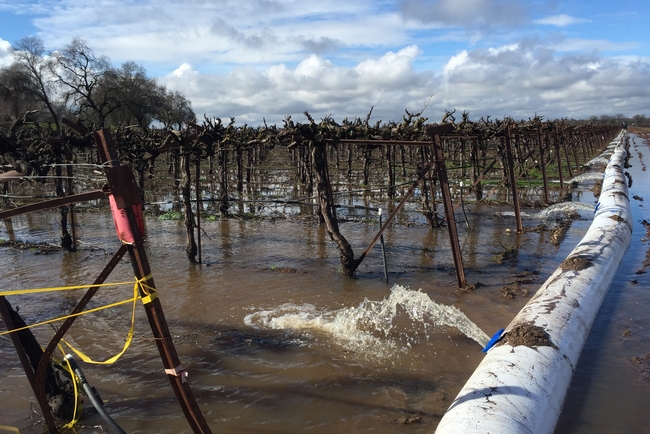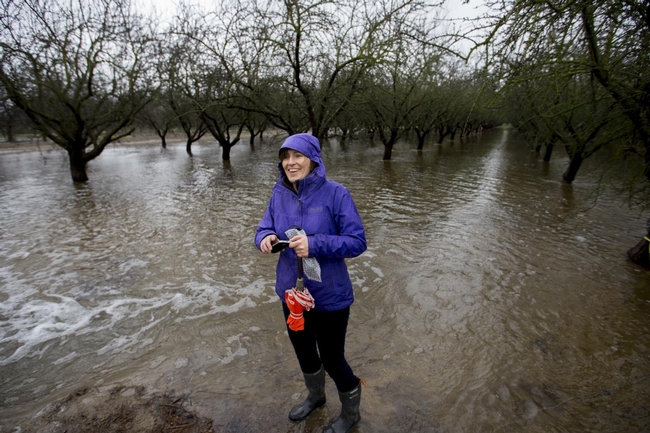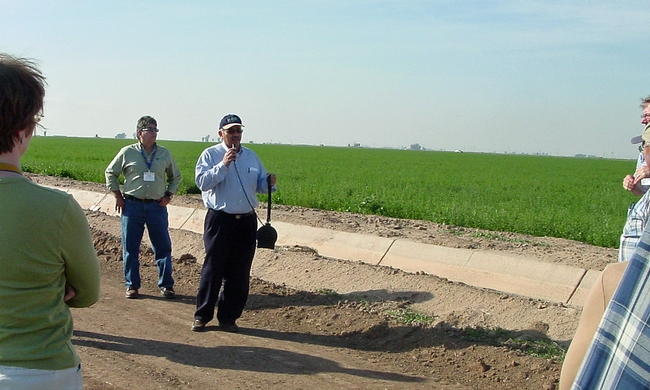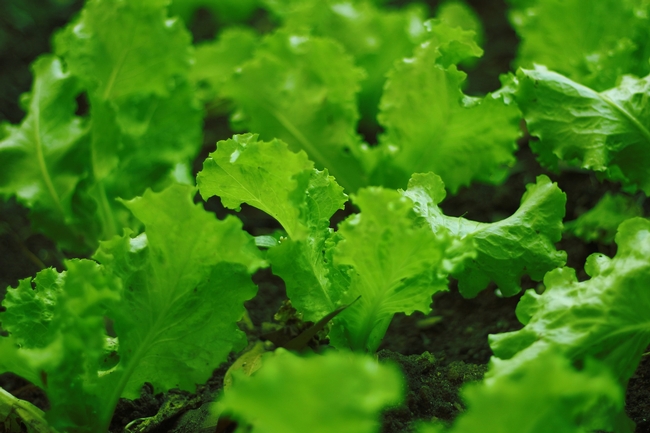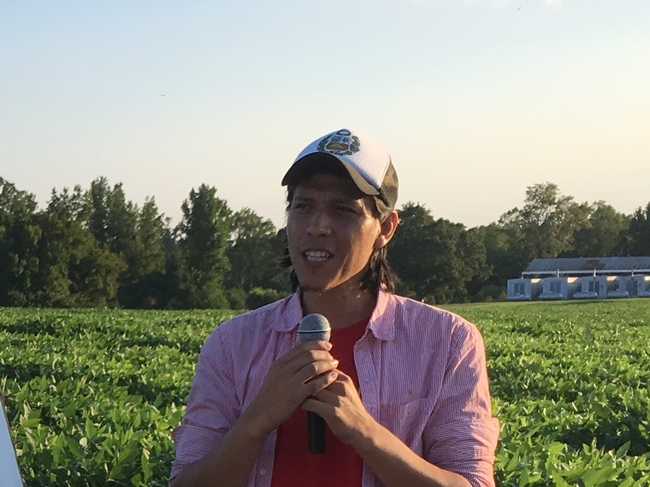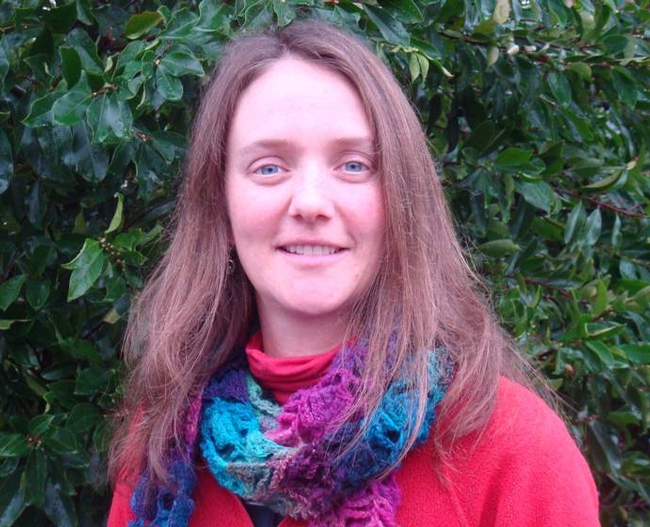Posts Tagged: Khaled Bali
Targeted wintertime flooding on ag fields could improve the water supply for rural Californians
When droughts strike California, people who rely on shallow domestic wells for their drinking, cooking and washing water are among the first to feel the pain. Aquifers have become depleted from decades of overuse. Drilling deeper is an option for farmers, but prohibitively expensive for low-income residents in disadvantaged communities in the San Joaquin Valley.
A UC scientist believes managed aquifer recharge on agricultural lands close to populations with parched wells is a hopeful solution.
Helen Dahlke, professor in integrated hydrologic sciences at UC Davis, has been evaluating scenarios for flooding agricultural land when excess water is available during the winter in order to recharge groundwater. If relatively clean mountain runoff is used, the water filtering down to the aquifer will address another major groundwater concern: nitrogen and pesticide contamination.
“The recharge has the potential to clean up groundwater,” she said.
Five years ago, UC Cooperative Extension specialist Toby O'Geen developed an interactive map that identifies 3.6 million acres of California farmland with the best potential for replenishing the aquifer based on soil type, land use, topography and other factors. Dahlke and her colleagues analyzed the map and identified nearly 3,000 locations where flooding suitable ag land will recharge water for 288 rural communities, half of which rely mainly on groundwater for drinking water. The research was published by Advancing Earth and Space Science in February 2021.
“If we have the choice to pick a location where recharge could happen, choose those upstream from these communities,” Dahlke said. “Recharge will create a groundwater mound which is like a bubble of water floating in the subsurface. It takes time to reach the groundwater table. That bubble floating higher above the groundwater table might just be enough to provide for a community's water needs.”
Filling reservoirs under the ground
Many climate models for California suggest long-term precipitation amounts will not change, however, the winter rainy season will be shorter and more intense.
“That puts us in a difficult spot,” Dahlke said. “Our reservoirs are built to buffer some rain storms but are mainly built to store the slowly melting snowpack in the spring. In the coming years, all the water will come down earlier, snowmelt likely in March and April and more water in winter from rainfall events.”
She is working with water districts and farmers to consider a change in managing water in reservoirs.
“We want to think about drawing reservoirs empty and putting the water underground during the fall and early winter. Then you have a lot of room to handle the enormous amounts of runoff we expect when we have a warm atmospheric river rain event on snow in the spring,” she said. “However, farmers are hesitant. They like to see water behind the dams.”
Interest in groundwater banking has been lifted with the implementation of the 2014 Sustainable Groundwater Management Act (SGMA). The law requires governments and water agencies to stop overdraft and bring groundwater basins into balanced levels of pumping and recharge by 2040. Before SGMA, there were no statewide laws governing groundwater pumping and groundwater was used widely to irrigate farms when surface supplies were cut due to drought.
“For some of the drought years, overdraft was estimated to be as high as 9 million acre-feet a year,” Dahlke said.
Dahlke believes wintertime flooding for groundwater recharge can help water districts meet SGMA rules. “We have to do anything we can to store any surplus water that becomes available to save it for drier times and our aquifers provide a huge storage for that,” she said.
Farming impacts
The Dahlke lab is collaborating with UC Agriculture and Natural Resources farm advisors and specialists and with scientists at other UC campuses to learn about agronomic impacts of flooding a variety of agricultural crops, including almonds, alfalfa and grapes.
In the San Joaquin Valley, UC Cooperative Extension irrigation specialist Khaled Bali led an intermittent groundwater recharge trial on alfalfa. The researchers applied up to 16 inches per week with no significant impact on alfalfa yield.
“You could do groundwater recharge in winter and then turn the water off completely and still get a cutting or two of alfalfa before summer,” he said.
This past winter, Dahlke was prepared to flood 1,000 acres of land with water from the Consumnes River. Even though winter 2020-21 was another drought year, the research will go on. Her team was able to flood a 400-acre vineyard and, in collaboration with scientists from UC Santa Cruz, deploy sensors in the field to measure infiltration rates to better understand whether sediment in the flood water could clog pores in the soil. Her team also collaborates with Ate Visser of Lawrence Livermore National Laboratory in using isotope and noble gas data to determine the groundwater age and flow.
The Dahlke Lab's groundwater banking project has planned more studies in groundwater basins across the state to close knowledge gaps on suitable locations, technical implementation and long-term operation. They also plan to address operational, economic and legal feasibility of groundwater banking on agricultural land.
UC ANR to work with farmers to apply artificial intelligence technologies in the field
UC Agriculture and Natural Resources will receive $865,000 to help farmers in the Colorado River basin and the Salinas Valley integrate digital tools and artificial intelligence into their growing systems. The funds are part of a $10 million Sustainable Agricultural Systems grant from the USDA's National Institute of Food and Agriculture to improve the sustainability of the nation's food supply.
The intensive agricultural industry of the Colorado River basin – which includes the Palo Verde, Coachella and Imperial valleys in California; the Yuma Valley and other areas, such as Wellton-Mohawk Valley in Arizona – produces vegetables in the winter that are shipped across the country. Salinas Valley farms produce vegetables in the summer for markets throughout the nation.
“Vegetables are an essential part of a healthful diet. With this grant, NIFA is recognizing the role that California, Arizona and Colorado play in growing nutritious food for Americans,” said Khaled Bali, UC Cooperative Extension irrigation specialist. “The sustainability of these production systems into the future, particularly in light of challenges like climate change, increased drought and limited access to surface and groundwater, will require sophisticated technology.”
U.S. agriculture industry professionals are world leaders in the use of technology, including automation, drip irrigation, sensors and drones. “What's new is how you can now integrate technology into making decisions,” said Bali, who is leading the digital agriculture education and outreach aspect of the grant.
Bali said new farming tools work like smart thermostats in homes, which have sensors throughout the house and learn family patterns to make conditions perfectly comfortable throughout the day and night.
On the farm, instead of applying the same amount of water and fertilizer over hundreds of acres, sensors, valves and digital management allow small sectors to get treatments based on soil type, size of plants, pest pressure, salinity and disease management.
“This project will lay the foundation for a long-term shift to highly automated mechanized farm management systems – with full implementation likely decades in the future,” Bali said. “The precise application of inputs in agriculture will save water, reduce the percolation of fertilizer below plant roots, reduce the need for manual labor in the industry, increase yields and decrease expenditures, enhancing the industry's economic viability.”
Field demonstrations, training sessions, videos and handouts will bridge the gap between ongoing farming practices and academic and industry state-of-the-art digital technology. These activities are expected to increase the productivity and competitiveness of major crop growers.
The new project will expand the usage of a smartphone and website app called CropManage, a system developed in 2011 by Michael Cahn, UC Cooperative Extension advisor in Monterey, Santa Cruz and San Benito counties. CropManage allows farmers in the Salinas Valley to input information about their crops and soil, and then automatically receive recommendations about irrigation and fertilization needs that take into account weather conditions reported by the California Irrigation Management Information System (CIMIS), a network of automated weather stations managed by the California Department of Water Resources.
Currently, CropManage makes about 2,000 recommendations to Salinas Valley farmers each month during the growing season. The new funding will allow for the expansion of CropManage to help farmers manage salinity.
“To minimize salt toxicity to the crop, farmers may need to apply water to leach salinity below the root zone. But we don't want to leach nitrates,” Cahn said. “We want to decouple these processes and do the leaching when there are lower nitrogen levels in the system. Determining timing and water amount is something we will build into CropManage.”
The grant will also provide funding for new training and outreach that will enable more farmers to use the CropManage app.
The overarching $10 million grant awarded to UC Riverside is led by professor Elia Scudiero, an expert in soil, plant and water relationships. He and a team of UC Riverside scientists will develop artificial intelligence data needed for smart farming systems with new statistical and algebraic models that find repeated and generalizable patterns.
Another key piece of the effort will be supplying the agriculture industry with the next generation of growers, managers and scientists. Funds from the NIFA grant will establish a Digital Agriculture Fellowship program to recruit more than 50 data, environmental or agricultural science students over the next five years to develop and learn the technology. Internships with key commercial partners are also a feature of the program.
ANR in the news April 1-18
How One Entomologist Found His Calling as an IPM Facilitator
(Entomology Today) Lina Bernaola, April 18
Alejandro Del Pozo-Valdivia, Ph.D., is currently an IPM entomology advisor at the University of California Cooperative Extension. He serves the vegetable industry in the Central Coast region of California by conducting applied research on pest management and implementing an extension program for stakeholders.
Alejandro was born and raised in Lima, Peru, where he earned his bachelor's degree in agronomy from La Molina National Agrarian University. Then, he went to Washington State University, where he obtained his master's degree in entomology working on integrated pest management (IPM) in irrigated hybrid poplars. In 2016, he obtained his Ph.D. in entomology at North Carolina State University (NCSU). During his doctoral studies, he worked on proposing management practices for the kudzu bug, an invasive pest of soybeans.
America's leading animal geneticist wants to talk to you about GMOs
(Pacific Standard) Emily Moon, April 18
At 11 a.m. on a Thursday morning, Alison Van Eenennaam is sitting in a harshly lit lab room, surrounded by her graduate students, talking about cattle sex—sex that, unfortunately, has not gotten anything pregnant. With the gene-editing techniques she's using, there could be many factors to blame: the location in the DNA strand of the edit, the biopsy performed to check the results of the edit, the freezing and the thawing of the embryo, the embryo's journey from lab to farm in a thermos. Now, Van Eenennaam floats another idea. "No foreplay, the poor guy," she says, a cheeky grin on her face. "The candle and the lighting wasn't right."
https://psmag.com/environment/americas-leading-animal-geneticist-wants-to-talk-to-you-about-gmos
UCCE Marin Creates Online 'Story Map' Annual Report
(Patch) Susan C. Schena, April 16
The University of California Cooperative Extension team in Novato has created an online "story map" that capsulizes in an interactive way its ongoing programs and key 2018 accomplishments, instead of a written annual report.
https://patch.com/california/novato/ucce-marin-creates-online-story-map-annual-report
An Inviting Summary of UCCE Marin's Exploits
https://postnewsgroup.com/2019/04/18/an-inviting-summary-of-ucce-marins-exploits/
Why bees swarm and what you should – or shouldn't – do about them
(San Jose Mercury News) Rebecca Jepsen, April 16
…Last year was a particularly bad year for honey bees. Some bee keepers reported up to a 90 percent loss in their hives in 2018. Causes for this include varroa mite infestations, increased pathogens due to the warm weather, increased use of pesticides and a decrease in diversity of food sources.
So, what can we do about a swarm? “If you leave the bees alone, they will leave you alone.,” said Dr. Elina L. Niño, honey bee expert at UC Davis. “It only takes a few hours or at most a day or two for them to find and settle into their new home.”
https://www.mercurynews.com/2019/04/16/why-bees-swarm-and-what-you-should-or-shouldnt-do-about-them/
Santa Maria expects big strawberry crop
(The Packer) Carol Lawrence, April 16
…Two of the three top-yielding varieties in production yield studies conducted in Watsonville by the University of California, Davis, include the monterey variety, producing 10,554 cartons per acre, and the san andreas variety, which yielded 10,414 cartons per acre. O'Donnell said the commission has noticed those varieties as well as some proprietary ones from growers.
“We're seeing more fruit per acre from when these fruits are planted,” she said.
A newer variety, the cabrillo, was reported as producing 11,605 cartons per acre in recent tests.
https://www.thepacker.com/article/santa-maria-expects-big-strawberry-crop
These California communities could be the next Paradise. Is yours one of them?
(Sacramento Bee) Ryan Sabalow, Phillip Reese and Dale Kasler, April 11
…“There's a lot of Paradises out there,” said Max Moritz, a fire specialist at UC Santa Barbara.
California's state-of-the-art building codes help protect homes from wildfire in the most vulnerable areas, experts say. But the codes only apply to new construction. A bill introduced by Assemblyman Jim Wood would provide cash to help Californians retrofit older homes.
“This will go a long way toward these different municipalities (in showing) that they deserve funding,” Moritz said.
https://www.sacbee.com/news/state/california/fires/article227589484.html
U.C. Davis Animal Science Professor Discusses Agriculture's Contribution to Climate Change
(Cornell Sun) Stacey Blansky, April 11
On Monday afternoon, Prof. Frank Mitloehner, animal science and Air Quality Extension Specialist at the University of California, Davis, discussed the latest research surrounding animal agriculture and its “surprisingly modest” contribution to global greenhouse emissions. Mitloehner pointed at food waste as the largest contributor to environmental damage.
Scientists studying smoke taint as next fire season approaches
(Farm Press) Lee Allen, April 10
…A Los Angeles Times report on the subject put it this way - “Smoke taint rears its head when grapes, kissed by environmental smoke as they're growing, eventually yield a wine with unexpected smoldering flavors…, ‘like drinking from a well-used ashtray,'” using the words of University of California-Davis enology specialist Anita Oberholster. The story noted: “It's a vintner's worst horror movie nightmare - the smoke is coming from inside the grapes.”
Says Oberholster: “Compounds that are responsible for smoke taint are naturally present in grapes at low levels, they add complexity to the wine. Research into the subject is a slow process and to date, I can say there is very little you can do to prevent extracting smoke taint compound from grapes. We are currently in the process of evaluating different amelioration techniques from finished wines and there is some promise there, but research is still on-going, and I have no data yet.”
https://www.farmprogress.com/grapes/scientists-studying-smoke-taint-next-fire-season-approaches
The farmer that saw his budding California tea farm go up in smoke
(San Francisco Chronicle) Jonathan Kauffman, April 8
…What Mike Fritts didn't know in 2010 — what almost everyone had forgotten, in fact — was that the UC Extension Service planted California's first modern test plot of Camellia sinensis in Fresno in the 1960s, when it partnered with Lipton.
Jacquelyn Gervay Hague, a chemist at UC Davis who conducts studies of tea-growing in Taiwan and is active in the university's Global Tea Initiative, said she learned about the plots just a few years ago when the director of UC Extension's Fresno office gave her a call.
“It blew my mind,” Hague says. She pored over the records, which covered 1963 to the early 1980s, when Lipton pulled out of the study. “It was concluded that we could grow tea very well,” she said.
https://www.sfchronicle.com/food/article/The-farmer-that-saw-his-budding-California-tea-13745160.php
Goats are the latest weapons in the war against wildfire
(CNN) Sarah Lazarus, April 8
… Lynn Huntsinger, professor of range ecology and management at the University of California, Berkeley, says that California has seen an increase in "fuel" -- the term fire experts use to describe "dead plants."
Huntsinger, who used to keep goats in the backyard of her Bay Area home, says the fire problem has its roots in history.
In the past, Native Americans lit fires to control the vegetation, she says. These deliberate burns created a landscape of open grasslands, so wildfires were smaller and less frequent.
That changed with the arrival of colonial settlers. They did not understand how "using fire prevented fire," and banned deliberate burns from around the turn of the 20th century, says Huntsinger.
https://www.cnn.com/2019/04/08/americas/goats-and-wildfires-intl/index.html
The Age of Robot Farmers
(The New Yorker) John Seabrook, April 8
…To get an idea of what might be possible, I arranged to visit Professor David Slaughter in his office at the University of California at Davis. Slaughter leads the university's Smart Farm Initiative, which explores how future farmers might employ emerging technologies. Drones, for example, can automate the inspection of fields for pest or weed outbreaks, and can use high-resolution cameras and algorithmic processing of the images to pick up incipient problems before a farmer or a hired hand might spot them. Another possible application is plant breeding. Breeders currently rely on humans to evaluate seedlings produced by new combinations of already existing varieties.
…If the future of fruit-and-vegetable farming is automation, farmers will not only need the machines, and the funds to afford them, they will also require a new class of skilled farm workers who can debug the harvesters when something goes wrong. Mary Lou de Leon Siantz, a colleague of David Slaughter's at the University of California at Davis, is trying to ensure that domestic farmworkers' children have the STEM skills to compete for those jobs. De Leon Siantz is the daughter of Mexican immigrants; she has a Ph.D. in human development and focusses on migrant health in her research. She hopes to use existing Head Start and 4-H programs to teach math and engineering.
https://www.newyorker.com/magazine/2019/04/15/the-age-of-robot-farmers
Regional sustainable groundwater management forum hosted in Corning
(Red Bluff Daily News) Julie Zeeb, April 5
Tehama and Butte counties teamed up Friday to host a Northern Sacramento Valley forum on sustainable groundwater held at Rolling Hills Casino.
The event was a collaboration between the Tehama County UC Cooperative Extension and Butte County Department of Water and Resource Conservation.
Allan Fulton, a Tehama County farm advisor, served as moderator.
“We're four years into Sustainable Groundwater Management Act that went into affect Jan. 1, 2015,” Fulton said. “There's been a lot of organizing (of groundwater management agencies). Now the governance structure and planning is underway. This venue is perfect for people to learn about the act and what is going on locally. It's a chance to see, as landowners and water operators, how to engage in the process and give feedback on what they think about it.”
The worst fire in California history illuminates fire preparation needs
(Yuba Net) April 5, 2019
Four months have passed since the Camp Fire, the worst wildfire in California history, ravaged bucolic communities in the Butte County foothills, including Paradise, Concow, Butte Creek Canyon, Cherokee, Yankee Hill and Magalia. Eighty-five people died, many of them elderly and unable to safely evacuate from an area where a wind-driven fire raced from home to home.
The unspeakable loss of human life and the serious challenges being faced by survivors has dominated the Camp Fire conversation. Now, UC Cooperative Extension is beginning a dialog with many agencies involved to understand how such tragedies can be prevented in the future.
https://yubanet.com/regional/the-worst-fire-in-california-history-illuminates-fire-preparation-needs
UC course helps landowners track water use
(Farm Press) Tim Hearden, April 5
On a recent morning, Jim Edwards and about 70 of his fellow farmers and ranchers from Northern California went back to school. Each was handed a binder full of worksheets as they embarked on a three-hour course to learn how to measure and report their own water diversions – a state requirement now for landowners with rights to draw water from a river or stream.
There were lectures by University of California Cooperative Extension advisors and were even quizzes at the end of each unit so the landowners could demonstrate what they'd learned about open-ditch flow readings, measuring weirs, in-pipe flow meters, the calibration and accuracy of measuring devices, and measuring reservoir diversion quantities.
“I think it's great,” said Edwards, who takes water from Antelope Creek near Red Bluff to raise cattle, orchards and hay.
… “I think this is a good crash course to get people to understand flow measurements and what is required of them to report,” says Khaled Bali, a UCCE irrigation specialist who helps lead a course unit on device accuracy.
https://www.farmprogress.com/extension/uc-course-helps-landowners-track-water-use
DIY with classes at the UC Cooperative Extension in gardening and food preservation
(New Times SLO) Camillia Lanham, April 4
A soft-hued planter full of pale gray-greens and purple flowers waits just through the gate of the Garden of the Seven Sisters off Sierra Way. Those winter colors will soon be replaced by flora made just for spring. This "curbside garden" is the first of 15 demonstration plots manned by Master Gardener Program volunteers at the UC Cooperative Extension in San Luis Obispo.
If you're a newbie like I am—or an oldie looking for some new tricks—the UC Cooperative Extension in San Luis Obispo County has got something just for you. Whether you're trying to figure out what to do with all of that extra produce on your kitchen counter or trying to decide exactly what to plant and when, there's probably a class for that either through the extension's Master Gardener Program or Master Food Preserver Program. You can become certified as a master and volunteer for either program or both programs, or you can dabble with a class here or there.
Backyard chickens hit hard by a long-gone, extremely contagious disease
(New Food Economy) Tove Danovich, April 4
In California, backyard birds are in lockdown. County fairs are canceling their poultry shows. Veterinary hospitals aren't accepting chicken appointments. Local 4-H leaders are telling chicken owners to keep their birds sequestered. Some poultry breeders are even worried their birds will need to be euthanized.
… There are approximately 100,000 backyard flocks in California according to Maurice Pitesky, Cooperative Extension poultry specialist with the University of California, Davis, School of Veterinary Medicine. “They don't focus so much on biosecurity, which is just a fancy word for disease prevention,” he says. Backyard poultry owners regularly mock the CDC's advice to avoid snuggling or kissing their chickens, but that's not the worst of it: 25 percent of urban poultry owners reported not even washing hands after handling their birds.
https://newfoodeconomy.org/virulent-newcastle-disease-poultry-backyard-chicken-coops
Dr. Monica Cooper to be honored at ASEV in Napa June 19
(Napa Valley Register) April 4
Dr. Monica Cooper, farm adviser of UC Cooperative Extension, Napa Valley, is the recipient of the American Society for Enology and Viticulture's (ASEV) Extension Distinction Award for 2019.
Cooper will receive the award at the 70th ASEV National Conference on June 19 in Napa, where she will be presenting, “Building Effective Extension Networks to Support Data-Driven Decision Making.”
It Wasn't Just the Soda Tax That Dropped Berkeley Soda Sales by 52 Percent
(The Inverse) Emma Betuel, April 3
University of California, Berkeley professor Sofia Villas-Boas, Ph.D., and Ph.D. candidate Scott Kaplan show in the new paper that soda purchases fell between 10 and 20 percent on Berkeley's campus directly after the soda tax was passed but before the prices officially increased in 2015. They also used Nielsen data to show a similar pattern: soda purchases at local stores decreased by 10.8 percent even before the higher prices went into effect.
“The election outcome caused a 10-20% reduction in sales of regular soda beverages before consumers faced higher prices anywhere, on campus or in stores off-campus,” Kaplan tells Inverse, “This suggests that you might not witness these types of effects if a sugar-sweetened beverage (or soda) tax was implemented without a preceding campaign and public vote.”
https://www.inverse.com/article/54577-soda-taxes-and-changing-social-norms
UC IGIS to host DroneCamp 2019 in Monterey
(Santa Cruz Tech Beat) Sara Isenberg, April 2
The Informatics and GIS Program (IGIS) of University of California's Division of Agriculture and Natural Resources is pleased to host the second offering of DroneCamp. This three-day intensive workshop covers everything you need to know to use drones for mapping, research, and land management, including…
Tiny whiteflies seem to be bugging people across the Central Coast, but why are there so many this year?
(KSBY) Megan Healy, April 1
A master gardener from the SLO University of California Cooperative Extension says dozens of people from south SLO County called asking why there are so many.
“It's probably a reflection of the increasing temperatures coming on top of all that nice water we have had, so we have had a flush of vegetation and the flies that came from eggs originally have just all hopped out,” said Cathryn Howarth, a master gardener a the SLO County UC Cooperative Extension.
According to the UC Agricultural and Natural Resources Statewide Integrated Pest Management Program, signs of whitefly manifestation include…
Inside the race to build the burger of the future
(Politico) Michael Grunwald, April 1
…Conglomerates like Walmart, McDonald's and General Mills have been setting emissions reduction targets for their suppliers, which will ratchet up pressure on farmers and ranchers to green their operations. But at a time when they're already getting squeezed by a handful of giant agribusinesses that process their animals, as well as the economic fallout from President Donald Trump's trade wars, they're hoping for government incentives to reduce their emissions. Frank Mitloehner, a professor of animal agriculture at the University of California-Davis, believes farmers and ranchers deserve to be paid for their ecological services—and recently said so to an Ocasio-Cortez staffer. For example, California is spending hundreds of millions of dollars to help them manage their manure in cleaner ways, which makes more sense to Mitloehner than demonizing them for the messes they make while putting food on people's tables. Many of them are conservative Republicans who deny climate science, but they're also pragmatic businesspeople—Mitloehner says they could store tremendous amounts of carbon on their lands if the price and the politics were right.
“Politically, farmers tend toward the Trump camp, and when they hear all this finger-pointing about farting cows, they just shut down,” Mitloehner says. “It troubles me, because I know how urgent this climate discussion is.”
… “There's such an enormous opportunity to reduce emissions in meat production, if you didn't hear all this counterproductive talk about how everything about it is terrible,” says Mitloehner, the Cal-Davis agricultural scientist. “Let's not alienate the people we need the most on our quest for a climate solution.”
https://www.politico.com/magazine/story/2019/04/01/meat-politics-226342
ANR in the news March 1-11
Western Innovator: Putting biologicals to work
(Capital Press) Padma Nagappan, March 11
Early in life, Surendra Dara decided that no matter which field he chose, he needed to make an impact on it. Always interested in science, he chose agriculture and specialized in entomology.
“It attracted me because it dealt with arthropods and there are a lot of physiological similarities to the human world,” Dara said. “It was also critical for growing food and feeding humans.”
Dara is now an entomopathologist with the University of California's Division of Agriculture and Natural Resources in San Luis Obispo, and has an established reputation for exploring innovative options to control pests using microbials as biological controls, and showing growers how they can also help with plant growth, drought resistance and fighting diseases.
Group linked to Ocasio-Cortez seeks ag input after Green New Deal backlash
(Politico) Helena Bottemiller Evich, March 11
After watching that drama unfold, Frank Mitloehner, a leading scientist on agricultural emissions at the University of California, Davis, was thrilled when two outreach staff affiliated with AOC's network reached out to set up a call to discuss the potential for climate mitigation efforts in agriculture. The call, held earlier this month, lasted more than an hour, Mitloehner said.
“I was very glad to inform of what I know, and they were very receptive to it,” Mitloehner said on Agri-Talk last week. During the segment, he urged agricultural producers to not dismiss the left-wing climate effort.
Sudden surge in an unusual crime in Fresno County: Goat theft
(LA Times) Hannah Fry, March 11, 2019
…Picquette's two sons have been raising goats for the last five years as a 4-H project. Losing their animals has been especially hard for the boys, Picquette said, adding that they had planned to use money won during competitions to pay for college.
“They feel very violated. They don't understand how somebody could just come and take something they worked so hard for,” she said. “The bond we have with the goats is incredible. I'm just heartbroken. I don't know if they're scared or hungry. … They've always been treated so well.”
https://www.latimes.com/local/lanow/la-me-ln-fresno-goat-theft-20190311-story.html
California's ambitious plan to stop deadly wildfires may not be enough, experts say
(SF Chronicle) Kurtis Alexander, March 9
… “It's not fair to say that fuel treatments won't do any good,” said Max Moritz, a UC Cooperative Extension wildfire specialist at UC Santa Barbara. “It may provide some protection in some places. But most of us studying this agree that you can't just do this and (expect to) make much headway.”
The plan by the California Department of Forestry and Fire Protection, or Cal Fire, comes at the request of Gov. Gavin Newsom. On his second day in office, Newsom asked the agency to develop a proposal to address the increasingly destructive fire seasons that have rattled the state and are expected to worsen with climate change.
…In the meantime, many researchers say the most effective approach to fire protection is not in the forests, but in communities. They recommend making homes more resistant to fire with hardier construction materials, and clearing the vegetation around them.
“You have to address the home vulnerabilities themselves,” said Moritz at UC Santa Barbara. “If you don't, you're just not going to make a lot of progress on fire.”
After more than 140 years, a massive fig tree gracing the plaza where Los Angeles was founded collapses
(LA Times) Matthew Ormseth, March 9
… The four figs were planted at El Pueblo by agriculturalist and City Councilman Elijah Hook Workman, KCET reported in 2013. The Ficus macrophylla was brought from Australia to Southern California in the 1860s and 1870s, probably to provide shade and ornamentation, said Donald Hodel, a horticulture advisor for the University of California's Cooperative Extension.
Hodel described the Moreton Bay fig as a commanding breed of tree with an enveloping canopy that threw plenty of shade.
His reasons for admiring the Moreton Bay fig: “Their grandeur; their size — they have an imposing habit; their root structure is incredible; the spreading nature of their branches.”
Hodel said he last saw the El Pueblo figs about six years ago.
“I wasn't too impressed by their health or their size, considering they're 140-something years old,” he said.
https://www.latimes.com/local/lanow/la-me-pueblo-tree-falls-20190309-story.html
California's 2018 Was the Worst Ever Recorded for Wildfires
(Gizmodo) Tom McKay, March 9
University of California, Santa Barbara UC Cooperative Extension wildfire researcher Max Moritiz told the Chronicle, “It's not fair to say that fuel treatments won't do any good. It may provide some protection in some places. But most of us studying this agree that you can't just do this and (expect to) make much headway.”
https://earther.gizmodo.com/californias-2018-was-the-worst-ever-recorded-for-wildfi-1833180368
4-H leader who taught lost Benbow girls outdoor skills being flown to Washington, DC for recognition
Kym Kemp, March 7
When Leia Carrico, age 8, and her sister, Caroline, age 5, disappeared into the woods around their home near Benbow on March 1, the whole nation held its breath for the next 44 hours until they were found. But, though their 4-H leaders were worried, too, they say they also knew the girls had something many other children don't–they had survival skills from a class taught by their Outdoor Adventures 4-H project leader, Justin Lehnert.
Lehnert is being honored in Washington, DC, on Tuesday for his role in teaching Leia and Caroline outdoor skills.
Researchers highlight plan to eat healthy on a budget
(Consumer Affairs) Kristen Dalli, March 7
Following a healthy diet can come with a hefty price tag, but a team of researchers has outlined a way for consumers to stick to a healthy diet -- and also stick to their budgets.
According to the team, consumers -- and their families -- can have healthy meals if they focus on buying items in bulk and planning meals in advance.
“This study determines the likelihood that families living in low-income households could create meals that meet the USDA dietary guidelines presented in MyPlate nutrition education materials,” said researcher Karen M. Jetter, PhD. “In addition to food cost, the other factors considered were access to stores, time for meal preparation, and whether the menus included culturally appropriate foods.”
Healthy eating is possible on a limited budget, study shows
Study: Eating healthy on a budget is possible
https://www.upi.com/Study-Eating-healthy-on-a-budget-is-possible/9951551904010/
Eating Healthy Is Possible on a Small Budget, Says Study
https://www.askmen.com/news/sports/eating-healthy-is-possible-on-a-small-budget-says-study.html
Sorry, Alexandria Ocasio-Cortez, but “farting cows” aren't the problem
(New Food Economy) Sam Bloch, March 7
…As it turns out, neither side was accurate. Republicans are likely to continue linking Green New Deal priorities to a supposed hamburger ban. But if you don't hear about cow farts anymore from AOC, it may not be because of GOP criticism. Frank Mitloehner, an animal scientist and air quality specialist at the University of California, Davis, insists cattle flatulence isn't the problem it's made out to be, and says he helped set the record straight.
Here's what seems to have happened. On February 4, shortly before Ocasio-Cortez announced the Green New Deal, she was speaking to school children in Queens, New York. When one asked how they could “combat” climate change, Ocasio-Cortez offered two practical options—stop using disposable razors, and skip meat and dairy for one meal.
Mitloehner tweeted at her.
“Dear @AOC: we all try to help the climate,” he wrote. “However, the two options you offered have low impacts compared to the 800lb gorilla, which is to reduce fossil fuel use. About ? of greenhouse gas emissions in the US stem from transport and energy prod&use. Meat/milk = 4 % of total GHG,” referring to findings in a recent EPA report.
… “I give her team a lot of credit for reaching out,” Mitloehner says. “If we really are serious about making a difference in carbon emissions, you cannot do this without agriculture involved.”
California supplies a quarter of the world's sunflower seeds
(Capital Press) Padma Nagappan, March 7
…Khaled Bali is a University of California Department of Agriculture and Natural Resources statewide water and irrigation specialist who has been working since 2016 on a four-year trial on sunflower varieties.
He was asked by the University of Georgia to help ascertain which varieties were drought resistant. He chose to conduct his trial in the low desert region of the Imperial Valley, since it gets little rain during the growing season between February when it's planted, and June when it's harvested. This would make it easier to control and measure the actual water applied to the crop varieties.
“We're looking at 285 varieties of sunflowers, to see which ones do well under stress,” Bali said. He has tested different plantings each growing season for the past three years, and will finish the trial this year.
https://plantingseedsblog.cdfa.ca.gov/wordpress/?p=17375
Livestream coverage of fire protection panel discussion in Nevada City
(Sierra Sun) March 7
…Following the films, the community is invited to join an ongoing conversation around the new reality of living with fire in the wildland urban interface. Panelists represent a diverse cross-section of the wildfire prevention community including: Cal Fire, Fire Safe Council of Nevada County, Nevada County Office of Emergency Services, Nevada County Resource Conservation District, Pacific Gas and Electric Company, Tahoe National Forest and University of California Cooperative Extension. The panel discussion will be moderated by YubaNet Co-founder Pascale Fusshoeller. [Kate Wilkin, UCCE fire advisor, participates on the panel in the last hour of the video.]
Bees, blooms off to slow start
(Western Farm Press) Logan Hawkes, March 6
…This year, almond bloom started around a normal time, with some early varieties showing a few open flowers in the first week of February,” reported Franz Niederholzer, UCCE farm advisor for Colusa, Sutter, and Yuba Counties. “For most of the month bloom progressed very slowly,”
By the middle of February, he says, “bloom for Nonpareil was at least two weeks behind, and bee hours were limited until the last week of the month. Last year, between Feb 1-20, we accumulated 130 bee hours of good honey bee flying weather [55 F., no rain, and wind less than 10 mph]. For the same interval this year, we had around 10 hours and only six of those occurred with open flowers in the orchard.”
On the positive side of the slow start, Niederholzer says, the colder weather tends to suppress activity of key bloom diseases such as blossom brown rot and anthracnose. “However, cold weather at bloom was conducive to blossom blast (pseudomonas) bacteria, and some growers were considering adding materials to their normal bloom fungicides with bactericide activity.”
https://www.farmprogress.com/tree-nuts/bees-blooms-slow-start
Wet winter aids groundwater replenishment
(Ag Alert) Christine Souza, March 6
… Helen Dahlke, a hydrology expert and professor with the University of California, Davis, Department of Land, Air and Water Resources, has been working with farmers, studying on-farm groundwater recharge locations and suitability for various crops.
"In many regions, we can definitely do more actively recharging our groundwater aquifers," said Dahlke, who currently has trials on alfalfa at the UC Kearney Agricultural Center. "It really depends on what region, how much surface water is available for recharge, what kind of sediment structure or hydrogeology we have underneath and whether it's suited for conveying large amounts quickly."
Despite abundant precipitation in recent weeks, she said the timing is not the best for studying impact of recharge on certain crops.
"We prefer on-farm recharge to happen in January and February, just because that is considered the dormancy season for most crops," Dahlke said. "With almond trees already blooming, often there is a greater risk of applying water on those crops."
She said recent precipitation has helped groundwater recharge overall, but there is "very little way of estimating how much it is helping."
http://www.agalert.com/story/?id=12797
Drip irrigation improves yields of Imperial sugar beets
(Ag Alert) Padma Nagappan, March 6
Halfway through a two-year irrigation trial to test furrow irrigation versus drip on sugar beet in California's Imperial Valley, Ali Montazar is looking for ways to boost yields with as little water consumption as possible in a region where furrow irrigation is the common practice.
Montazar, irrigation and water management advisor with the University of California department of agriculture and natural resources (UCANR) in Imperial County, is comparing and evaluating sugar beets for crop water use, sugar percentage, and yield, using both furrow and drip, since growers are now thinking of switching to subsurface drip.
Preliminary results from year one of the trial show that yield and crop water use are better with drip. Yield was 21 percent higher, and water use was a few points lower.
http://www.agalert.com/story/?id=12782
NFU says “No” to Green New Deal
(DTN) Jerry Hagstrom and Chris Clayton, March 6
Frank Mitloehner, an animal-science professor and air-quality Extension specialist at the University of California-Davis, reached out to Ocasio-Cortez's team about agriculture and the Green New Deal after seeing social media posts late last month about “farting cows” that drew a great deal of attention.
“I appreciate her interest in climate-change mitigation, but the 800-pound gorilla is the use of fossil fuels, and I told her that even the notion of cow flatulence makes this whole thing sound silly, and that's not what we need this discussion to be,” Mitloehner told DTN in an interview.
From Farting Cows to More Beans; Anti-Livestock Claims Fall Short
(AgriTalk) Jennifer Shike, March 5
The EAT-Lancet Commission on Food, Planet, Health is backpedaling as industry leaders and scientists poke holes in its “planetary diet” released in mid-January that is supposed to improve human health and planet health.
Air Quality Extension Expert Frank Mitloehner of the University of California Davis joined Chip Flory on AgriTalk Monday to discuss EAT-Lancet and Green New Deal in more depth.
4-H instructor who taught NorCal sisters how to survive in wilderness speaks out
(ABC7) Dion Lim, March 4
ABC7 News spoke exclusively to the 4-H instructor who taught two young girls the life-saving skills they needed to survive a weekend lost in the woods.
… Their mom, Misty Carrico, says she's not sure her daughters would have survived, if not for their 4-H program.
"The group leader Justin has taught them fire making skills and wilderness survival skills."
Justin Lehnert, the girls' 4-H leader, said, "I'm ecstatic that they did the job that they did. They're very strong girls and they stayed calm."
… Nine-year-old Caroline Gelormini has been a member of the San Bruno-South San Francisco 4-H Program for five years. Thanks to 4-H, she feels like she'd have a shot at surviving in the woods too.
Ocasio-Cortez Seeks Ag Data on Green New Deal
(Drovers) John Herath, March 4
When freshman congresswoman Alexandria Ocasio-Cortez released her Green New Deal plan, social media lit up with talk of her plan's mentions of “farting cows.” That drew the attention of agriculture's preeminent expert on air quality, Dr. Frank Mitloehner of the University of California at Davis, who tweeted back at the congresswoman.
“I don't know whether my tweet was the reason, but a few hours after I tweeted her, all mentioning of cow flatulence were taken off the web pages and of all social media outlets and was never to be heard again,” Mitloehner told Chip Flory on the AgriTalk Radio Show Monday.
https://www.drovers.com/article/ocasio-cortez-seeks-ag-data-green-new-deal
2 missing Humboldt County girls found — ‘absolute miracle
(SF Chronicle) Michael Cabanatuan, March 3
…Little additional information was available on how the girls went missing or how they survived, but Honsal said they had been trained in outdoors survival as members of a 4-H program.
https://www.sfchronicle.com/news/article/Absolute-miracle-as-missing-Humboldt-County-13659375.php
Organic farm east of Denair does its part on climate change. It's getting an award
(Modesto Bee) John Holland, March 2
…The family won in the farmer/rancher category of the Climate Leadership Awards. The others:
- Researcher: Tapan Pathak of the University of California Cooperative Extension in Merced, who helps farmers adapt to climate change.
- Policymaker: Ken Alex, who was director of former Gov. Jerry Brown's Office of Planning and Research
- Legislative staff: Brett Williams, office of Assemblywoman Jacqui Irwin, D-Thousand Oaks
- Agricultural professional: Ruth Dalquist-Willard, UC Cooperative Extension, Fresno
https://www.modbee.com/news/article226956529.html
Eructation Inflation: Greenhouse Gas Emissions of Livestock
(Science for the Rest of Us) March 1
Put your nerd hat on -- we cover a lot of ground in this fast-paced discussion with Dr. Frank Mitloehner of the University of California-Davis about the greenhouse gas emissions associated with the meat and dairy we consume. We consider how livestock emissions compare to other sectors of the US and global economies, the carbon footprint of vegetarian diets and what is the most effective way to reduce individual carbon emissions.
Keeping the Carbon Footprint of Livestock in Perspective
(AgNet West) Brian German, March 1
…“It is irresponsible and it's misguiding the public to believe that the true sources of pollution are downplayed, and the impacts of animal agriculture are grossly inflated,” said Dr. Frank Mitloehner, Professor and Air Quality Specialist in Cooperative Extension in the Department of Animal Science at the University of California, Davis.
Radiant daisy-like sunflowers produce a valuable crop with little water
Sweeping acres of striking golden flowers may soon grace California's desert southwest. UC Cooperative Extension irrigation specialist Khaled Bali believes sunflowers may be an ideal crop for the state's most punishing agricultural region.
California produces more than 90 percent of the country's hybrid sunflower planting seed, which is shipped around the nation and world. The seed is used to grow sunflower seeds for a healthy snack or salad topper, and for seeds that are expressed into sunflower oil, valued for its clean taste and polyunsaturated fat.
Most California seed is produced on about 50,000 acres in the Sacramento Valley. But the plant's low water use and early maturity hold promise for production in Southern California's low desert.
Bali's research began two years ago with 1,800 plots of sunflowers, nearly 300 different genotypes, at the UC Desert Research and Extension Center in Holtville. All plants were well-watered for four weeks before drought treatment started. In 2016, the trial plots were irrigated at 60 percent of the area's ETo (the full amount of water used by well-irrigated, mowed grass in that environment), and at 100 percent.
“Sunflower is a California native species grown as a hybrid seed crop,” Bali said. “With limited water, we wanted to look at varieties that tolerate drought and stress.”
That year, Bali found significant variation in yield across the varieties, but no difference between plots that received 60 percent of ETo and 100 percent
“I've been doing deficit irrigation for a long time,” Bali said. “I never expected that.”
For the 2017 season, the 60 percent ETo plots were dropped to 10 percent to better understand the implications of severe drought on the sunflower cultivars.
“The emphasis in 2017 was to intensify our drought treatment, giving less water earlier and to quantify the genotypes' drought avoidance strategy by digging up roots and using computer image analysis to determine root traits,” Bali said.
Bali attributes the sunflower crop's low water needs to its deep tap root and crop production timing. Sunflower in the low desert may be planted from January to February, and harvested in May and June.
“Sunflower water needs are relatively low since they are harvested before the hottest part of the summer,” Bali said.
His research is continuing in 2018.
A new UC publication, Sunflower Hybrid Seed Production in California, is now under review and is expected to be available to producers in fall 2018. Written by UC Cooperative Extension advisor Rachael Long and colleagues, including Bali, the publication outlines crop production standards, land preparation, fertilization, pest management, harvesting and more.
Long said sunflowers are favored for crop rotations because they help in long-term management of weeds and diseases, the plants add biomass to the soil after harvest, and they are a profitable specialty field crop.
Read more about California sunflowers in a Green Blog post by Rachael Long, Sunflower seeds are boosting California's ag economy.


